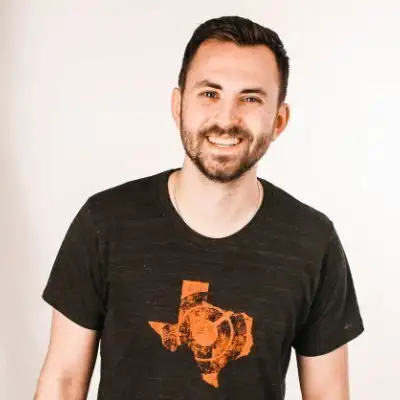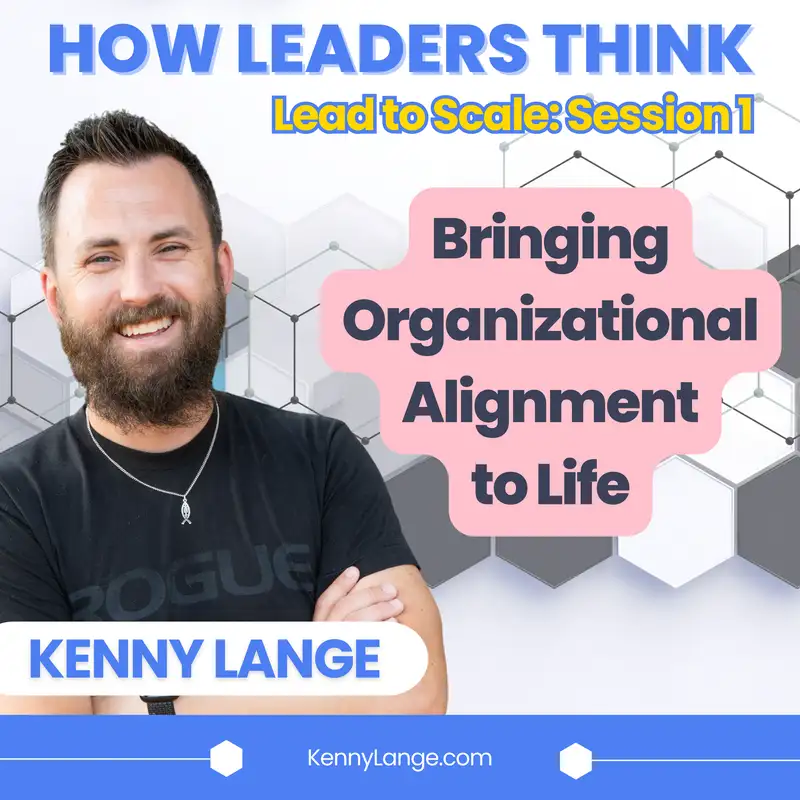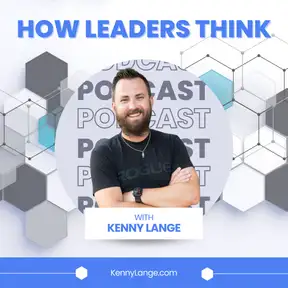How I Think About Bringing Organizational Alignment to Life
Practical Insights on Organizational Structure and Alignment: Kenny Lange Coaching
===
[00:00:00]
Kenny Lange: Welcome to the how leaders think podcast, a show that transforms you by renewing your mind and giving you new ways to think. I am your host, Kenny Lange. And with me today is the Kenny Lange? I'm Ron Burgundy? Today is going to be a little bit different. I am going to be your one and only host guest, like Judge, Jury, Executioner, although maybe not quite so dark.
I want to share in a series, and we're going to have a few of these, and I'd love to know what you think, but a series of questions. Teachings and episodes that come from a lot of the work that I do with clients. A lot of it, you hear come out in the conversations that I have with my wonderful guests.
But wanted to do a little something different this year to mix it up. So we're still going to have guests. On most weeks, we're just going to have [00:01:00] some of these peppered in. And I would love to know what you think. Now, this particular episode is going to be about creating organizational alignment.
It's one of the top, most requested services, pain points from clients people I'm working with from topics I'm asked to speak on. And this video is actually going to be coming out of the archive, so to speak. I run an online community leadership group is called the integrated growth network.
may not have heard me talk a lot about it since middle, late last year. But we have this great community I think it's a great place for people to dip their toe in the water. We have a link to it in the show notes uh, network dot Kenny Lang dot com is a place where you can go to find out more.
There's a little welcome video to explain in more detail, So this video comes from one of the monthly impact sessions.
It's where I'll teach a little bit about the theme of the month, and then we'll have a live Q [00:02:00] and a this particular one was just a teaching, so there's none of the Q and a. But it's got a lot of content that I use when I kick off engagements a lot of practical steps and tips there we'll have some links to some of the documents and tools that I mentioned in the episode.
So grab those and let me know how it can help or if anything was unclear. But what also love. To have you join me and other leaders in the integrated growth network starts at 97 a month. I also offer some cohorts and other things in there if you're wanting to step up and have more individualized attention.
Otherwise join the community. We'd love to have you. And now let's get into it.
what I want to talk about today is organizational alignment. And specifically, how do we create clarity around the functions in our organization?
And then what each of those seats, each of those positions and roles needs to look like in order for there to [00:03:00] be. actual alignment because it doesn't take just an org chart to make that a reality. We've We got to go deeper and really create the clarity at the individual person seat level in order for that to come true.
I'm going to take you through something that is adjacent to the system and soul framework that I utilize when I teach and I talk and I train. Companies and teams on this. it comes from the four stages of psychological safety from Dr. Timothy Clark. So I'm going to share my screen. I want to show you a couple of things that I have found really helpful in mapping to the three levels.
But first I want to talk about how we get there. To those levels and that seat number 1 is we need to take a little bit of time and really think through what the core functions of our organization or our business are All right. So, as you can see these 5 core elements. I'll talk [00:04:00] about these 2 last, but commerce. Really that's sales and marketing. Uh, I've had some clients and some teams refer to that as the, the revenue function in the organization.
So it is a combined sales and marketing capacity is your delivery. It's it's programs. If you're a nonprofit, it may be service. some people call that operations. Although I think that, that, that. Probably is a term best reserved for the operator and that higher level term. And we can discuss why at a different time, but basically your ability to deliver on the things, the commerce, the sales and marketing teams have peaked interest in and sold.
Now you've got to make good on that. And then capital, and that can be human capital can be financial capital and any other kinds of new buzzwords that have come about over the last few years, but you've got to take care of the administrative side of your business. Otherwise, and your nonprofit.
Otherwise, you're not going to be selling and helping [00:05:00] anybody. When we have these 3, that's a good place to start and every organization has them, regardless of their tax status. So, For profit, nonprofit. You all have. Now, up above here is a little bit of a different relationship. So we have the visionary and the operator.
Visionary typically is that, that founder, that CEO, that executive director president sometimes uh, goes by many different titles, but they're the person who has the big ideas. They're the person who has 100 Ways that come to them and 100 ideas on how to move the organization forward before lunchtime and 99 of them are terrible.
It's usually that operator that second in command and there's some great books that are starting to come out about how do you hire a great second in command. The founder and CEO of vision spark not too long ago, wrote a book he wrote about how do you find and select a great 2nd and command?
looking for fractional 2nd, and command books uh, Ben wolf wrote a great. Book, I called fractional leadership, [00:06:00] but this operator is responsible for creating that bridge between the visionary and the rest of the organization of taking vision, making it reality. Now, have mission, they have KPIs, they have responsibilities.
I actually don't work in that order. I do mission, responsibilities, then KPIs. something I dropped in the community was the car model document on how do you walk through understanding, clarity, autonomy, and results.
So, So often we're trying to hold people accountable for results having created. Clarity and a lot of times autonomy looks more like abdication. I know that that sounds like a 7 dollar word. Really all that means is you said I needed to do this thing. And instead of really guiding them, leading them managing them appropriately, not micromanaging, but managing them appropriately.
You actually were two hands off. I tend to fall into that category as opposed to being a micromanager, but it is our job as leaders to create clarity at the [00:07:00] beginning the start and then give autonomy or guided autonomy as Dr. Clark would say. And then finally, we can hold them accountable for results.
are some sample other responsibilities, but if you're in a leadership position, car is something that is vitally important to you, bringing out the best the most good from your people, not in a manipulative way, but really seeing the, their capacity and their potential and bringing that more into the day to day.
And, that will And that allow you to do more with less. when we start getting into how we arrive at at all these things like beyond car? How do we decide on what these other responsibilities are? Most systems, other systems would encourage you to list uh, responsibilities. Most job descriptions have a list of and responsibilities day to day.
What's it look like to the day of the life of this? Position. Those are very common, but they're often not anchored by anything. And it's very difficult to understand [00:08:00] what winning looks like both to that person when they accept the position and to you as the leader when you're delegating these responsibilities, because that's really all a growing company is, is the continuation of delegation.
what I want to take time now to do is taking through this. What Dr Clark calls the 3 levels of accountability, which accountability is chief issue organizations. There was even some polls that came out from system and soul about what's the number 1 issue you face over month, year over year as you're And a lot of it is how do we. set up proper accountability? How do I hold my people accountable? what I want you to see here you notice uh, outcome process task and the level of autonomy goes up the further away we go.
Really the way that this flows outcome Is the mission, what mission are you sending this person on? sit probably up in this visionary operator.
See, you're a senior leader of some sort probably have your hand and deciding who does [00:09:00] what when and where in the organization, but that mission really is the outcome. What is the outcome? They are meant to drive for the organization. you can say commerce. Well, their, Their mission is to make money and I get it.
Closing deals might be the job of sales. But what if it's about creating attention from our ideal client profile and closing those deals suddenly? Now I have a bit more direction. And then once we get past the outcome. Right the ultimate outcome that's that we're meant to drive. Now we get into responsibilities.
Okay. So what processes Might a person with this outcome this mission asked of them what processes might they have ownership of? going to be responsible for your go to market strategies and probably some of the execution going to be responsible for pipeline design and management from the sales side.
going to be responsible for [00:10:00] marketing campaign. Design and execution and strategy some pretty big processes, Handoff sales to delivery or programs or whatever it is you're in a nonprofit space have marketing instead of sales, it's usually uh, called development, but you still have marketing.
development responsible for creating the annual development plan? Are they marketing and development might be responsible for 3 largest annual plan. Events and galas and, whatever it is. So those are some things that could be there.
Now, someone with this outcome in this mission, who has been tasked with these processes. that makes sense if you're going to. Deliver this outcome, we've got to delegate that authority. If If we ask this of somebody, we have got to delegate authority over the processes that it would take to deliver this outcome.
Otherwise, you've just handicapped a person in terms of their effectiveness. By [00:11:00] taking away their ability to effectively achieve this outcome, which means that they got to come to you like a little kid. Can I do this? Can I do this? Can I do this? Clark would call that paternalism, like, when we delegate responsibility like, we give someone respect, but not permission.
respecting them as a senior leader, we're not giving them the permissions a senior leader. have to give them these processes. Now, a leader, you're always wondering if I've delegated these things out. If I've said, hey, I'm not the best person to do it. is going to look over this?
are we going to define success? How are we going to define winning? will they know they're doing the right things? Right? And how will we know they're doing the right things? Right? So that we don't have to micromanage. And really what we can do is. Celebrate their successes and coach up any places where they're falling behind and that's tasks.
And those are the KPIs. I want to do is I want to this down here and maybe focus more on this document see the [00:12:00] definition here tasks and processes aren't monitored.
So long as goals are met and results are satisfactory. You can't account for every process and every task necessary to achieve an outcome. And truth be told that outcome is given. So that in the absence of a direct process. Proclamation memo instruction, this person can still move forward and achieve it.
It also expands the possibility for them to be creative. when look at these, we look at the amount of autonomy. It's guided autonomy. So you give space you're still coaching them. You may still check in. You're going to have your, your regular weekly or monthly meetings. then what you want is that original contribution that pushes boundaries.
Thank you. Steve Jobs was famous for saying we don't hire smart people and tell them what to do. We hire smart people saying tell us what to do. You don't want to be the lid on your organization. So therefore you delegate of this out and you're gonna end up likely with really innovative ideas that you never would have [00:13:00] come up with, or it would have taken you much longer to.
the process level, let's group a lot of these tasks. Consistent format structure. They have partial ownership, maybe not total, but partial. And they don't need to make a lot of decisions. you've set the boundaries execution successful without any micromanaging the process is the process.
Now, maybe they needed help coming up with it. Maybe you say, we need a documented process for this. don't want a lot of tribal knowledge. And by that, I mean, just knowledge. That's only held inside of our heads and our hearts and shared verbally. And then finally, at the task level, these are just singular has simple units of work. So it may be a number of calls you've made salespeople. It could be calling leads for a development director uh, person or professional, they may be calling and following up with their largest donors or potential donors.
Autonomy. This is closely monitored through the use of KPIs. And then you want them to have mastery. It's [00:14:00] like, if we do these things on a regular basis, we know we're likely to end up in success. You can't fully predict it. But we monitor these things at the right frequency, then we're very likely to end up achieving this.
High outcome amongst all the other outcomes that we want and the business, or the, organization, the nonprofit as a whole will be successful. And that sort of momentum is really addictive. It's empowering momentum. I heard someone say. you have momentum appear much better, smarter effective than you actually are.
And when you don't have it, it makes you look much worse than you actually are. And this is a great way for you to build that momentum. A friend of mine, Jonathan likes to say that we should measure habits weekly and outcomes monthly and quarterly. Now, is that a hard and fast rule? Not exactly. But when you do look for KPIs, don't just look at the outcome of task.
Look at all the actions. So instead of again, I'll go with [00:15:00] sales and development. Don't look at how many deals did you close? How many donors did you close? And the total value of those look at how many phone calls they're making. On a weekly basis now, monthly, quarterly, yeah, you've got some goals that you want to hit and fundraising and and sales and closing new deals.
Absolutely. But look at how many phone calls, how many emails, how many meetings that they take those sorts of things it's in capacity, the service, the programs how many tasks or past do many projects are. Over budget we We can start to look at a lot of these things that would tell us early on.
Like, We want the smoke detector, right? We, you know, long before while it's a small fire and it's easily manageable. We don't want to do it when it's too late. a little like managing your business or your organization only by a monthly or quarterly. P. and L. if that's the 1st time you're seeing where your finances are headed, it's a little late to do anything about it.
Wouldn't you rather know? Okay. Early on that things were going in the right direction with the [00:16:00] wrong. So that is how we create organizational alignment. Again, regardless of tax status and that's really the only big difference. You have a few different titles, but you have people and creating alignment.
going back to the org chart, time and time again has been one of the most critical solutions that I've been able to help people with. getting that right solves a lot of other smaller problems down the line. This really is the big domino to push over.
Thanks so much for joining me today on this new episode. I hope that you enjoyed it. Uh, if you didn't, that's okay. Let me know, what you would like to be different about it. Uh, I really do value your opinion and I make this podcast for all of the leaders who are on their way, who are trying to change, how you lead for the better, but until next time, change the way you think you'll change the way you lead.
We'll see you. All
Creators and Guests


